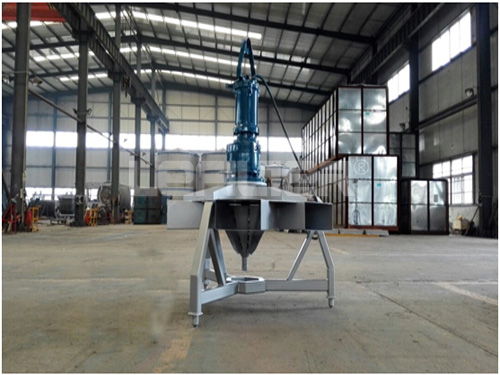The working principle of the submerged propeller in sewage treatment is as follows:
Motor drive: The core power component of the submerged propeller is the submersible motor. After the motor is powered on, it starts to run and provides power for the propeller. The motor usually has good waterproof, moisture-proof and corrosion-resistant properties, and can work stably underwater for a long time.
Impeller rotation: The output shaft of the motor is connected to the impeller to drive the impeller to rotate. The impeller is a key component of the propeller, and its shape and angle are specially designed. When the impeller rotates, it will exert force on the surrounding water.
Water flow movement:
Jet formation: As the impeller rotates, the water flow will produce a swirling jet. The water flow is ejected from the periphery of the impeller at a certain speed and direction, forming a jet with high speed and kinetic energy. This jet can generate strong water flow movement in a local area, driving the surrounding water to flow together.
Generate thrust flow: In addition to the swirling jet, the rotation of the impeller will also generate axial thrust flow. Axial thrust flow refers to the water flow being pushed along the axial direction of the impeller to form a forward water flow. This thrust flow can push the water in front forward, so that the water flows in the entire pool or treatment area.
Mixing and stirring: The swirling jet and axial thrust flow work together to form a large-area three-dimensional circulation and stirring effect in the water in the treatment area. This mixing and stirring effect is very important. On the one hand, it can fully mix various substances in the sewage (such as suspended matter, sludge, reagents, etc.) to improve the uniformity and efficiency of the reaction; on the other hand, it can prevent sludge and other substances from settling at the bottom, keep the water in the treatment area in a flowing state, and avoid dead corners.
Water circulation: Through the continuous operation of the submerged propeller, a stable water flow circulation is formed in the sewage treatment pool or treatment area. This water flow circulation helps to transport pollutants in the sewage to subsequent treatment equipment or process links, and improve the overall effect and efficiency of sewage treatment.
The following types of submerged propellers are commonly used in sewage treatment:
Low-speed submerged propeller:
Working characteristics: low speed, generally between 30-135r/min. Due to the slow speed, the water flow is relatively gentle, but it can form a large area of flow field, with a wide service range, and has a good flow-pushing effect. It can promote the overall flow of liquid in the pool and effectively prevent sludge precipitation.
Application scenarios: Suitable for regulating tanks, aerobic or anaerobic sections of oxidation ditches in various sewage treatment projects, and can also be used in industrial wastewater treatment pools, etc.
Advantages: compact structure, simple operation and maintenance, convenient installation and maintenance, and long service life; the impeller has a self-cleaning function to prevent debris entanglement and blockage; mixed use with the aeration system can greatly reduce energy consumption and significantly increase oxygenation.
Mixing submersible mixer:
Working characteristics: multi-pole motors are selected, and the direct-connected structure is adopted, with relatively low energy consumption and high efficiency. Its impeller design can generate strong stirring force, which can fully mix suspended matter, sludge and other substances in sewage with water to make the reaction more uniform.
Application scenarios: Commonly used in sewage treatment plants and industrial processes where solid-liquid two-phase or solid-liquid-gas three-phase media need to be uniformly mixed and reacted, such as in biochemical reaction tanks, hydrolysis acidification tanks and other process sections of sewage treatment.
Advantages: It can quickly achieve medium mixing and stirring, improve reaction rate and treatment effect; the equipment has a compact structure and a neat and smooth appearance design.
Vertical circulation mixer:
Working characteristics: According to the speed, it can be divided into medium-high speed stirring series and low-speed stirring series. The medium-high speed stirring series has a relatively high speed and a relatively small service range, but the stirring is relatively gentle; the low-speed stirring series has the characteristics of low speed, large service range, high hydraulic efficiency, and uniform stirring.
Application scenarios: The medium-high speed stirring series can be used in anaerobic or anoxic treatment of sewage treatment plants; the low-speed stirring series can be used in regulating tanks of various sewage treatment projects, and can also be used in anaerobic or anoxic tanks.
Advantages: The appropriate stirring method can be selected according to different treatment requirements and pool structure, and it has strong adaptability; it can form a large cycle of up and down tumbling, realize large-area three-dimensional circulation stirring, keep the sludge in the pool in a tumbling and suspended state, increase the contact surface of the material phase, and eliminate the stirring dead corner.
{sval:sql sql='SELECT n_parameter FROM dede_addonarticle WHERE aid = ~aid~ ' } {/sval:sql}
{sval:sql sql='SELECT n_parameter FROM dede_addonarticle WHERE aid = ~aid~ ' } {/sval:sql}











